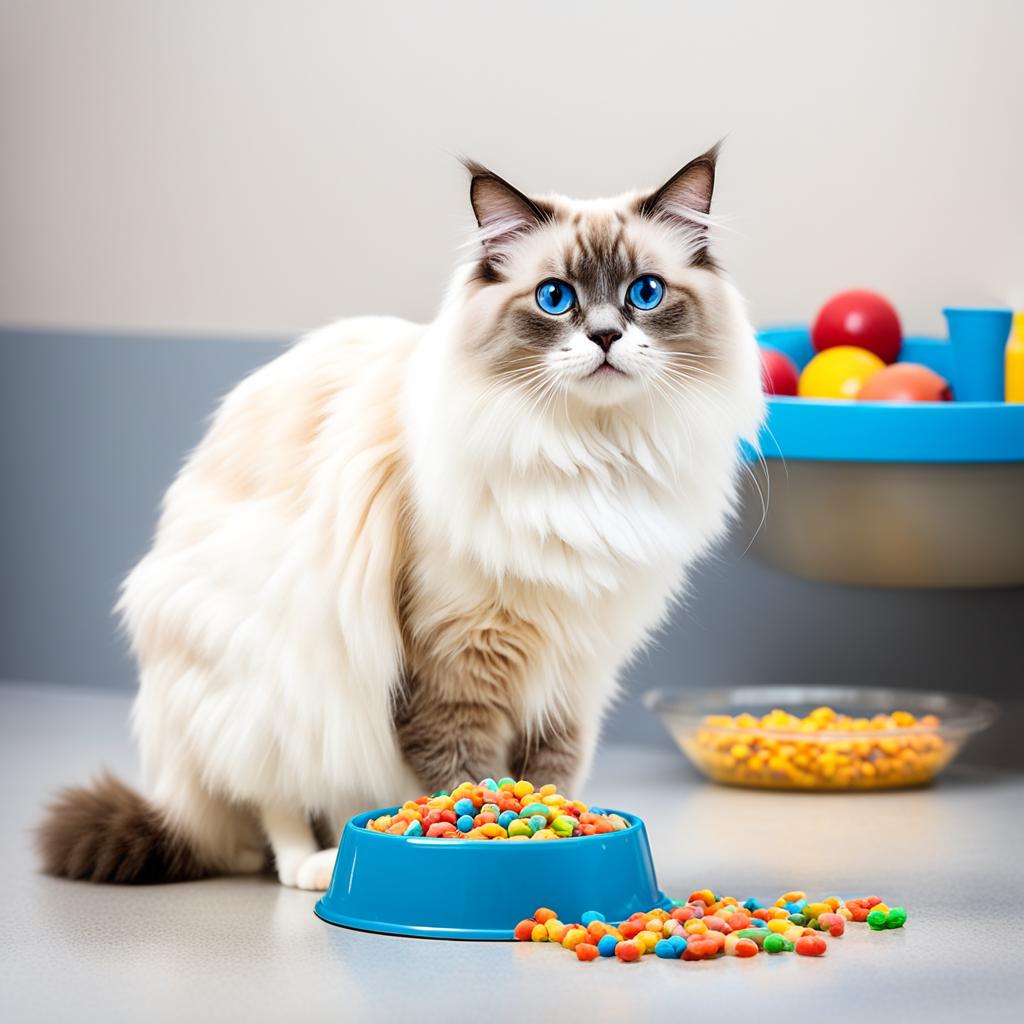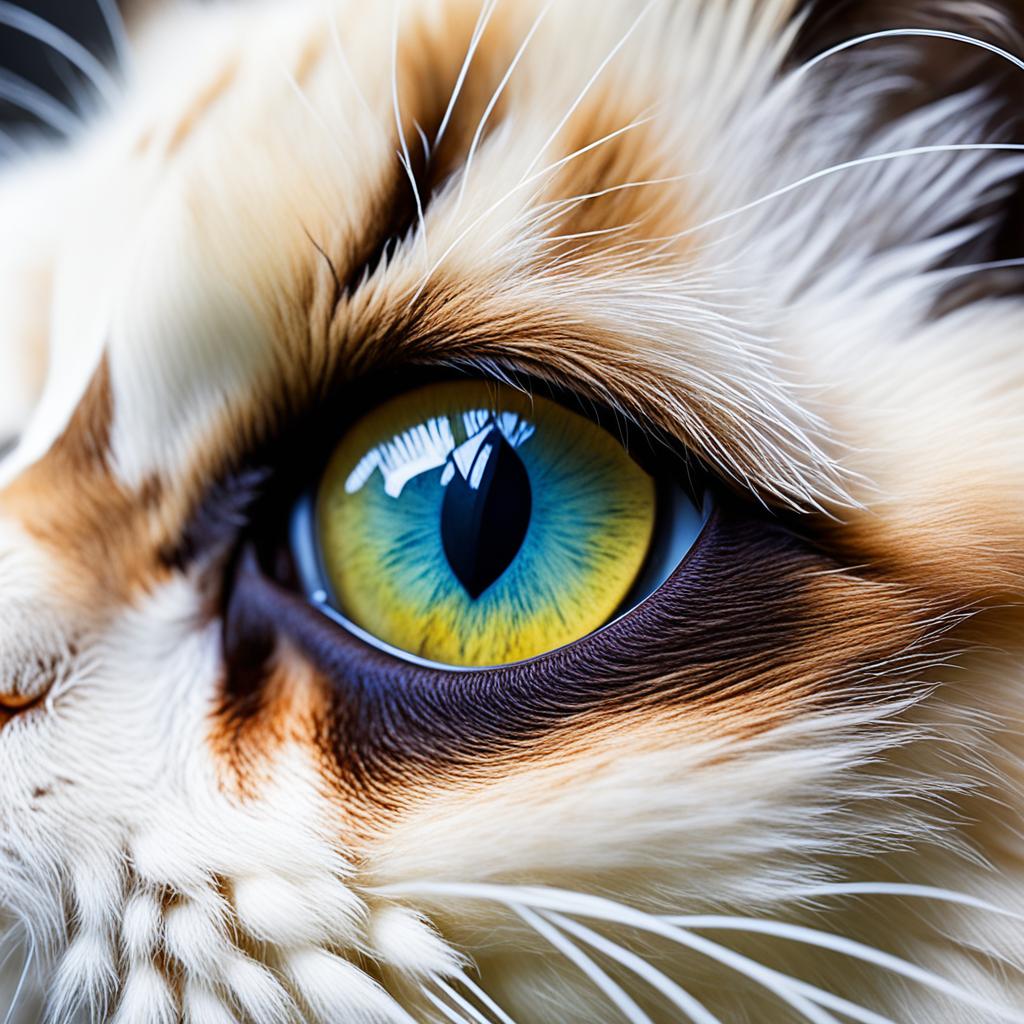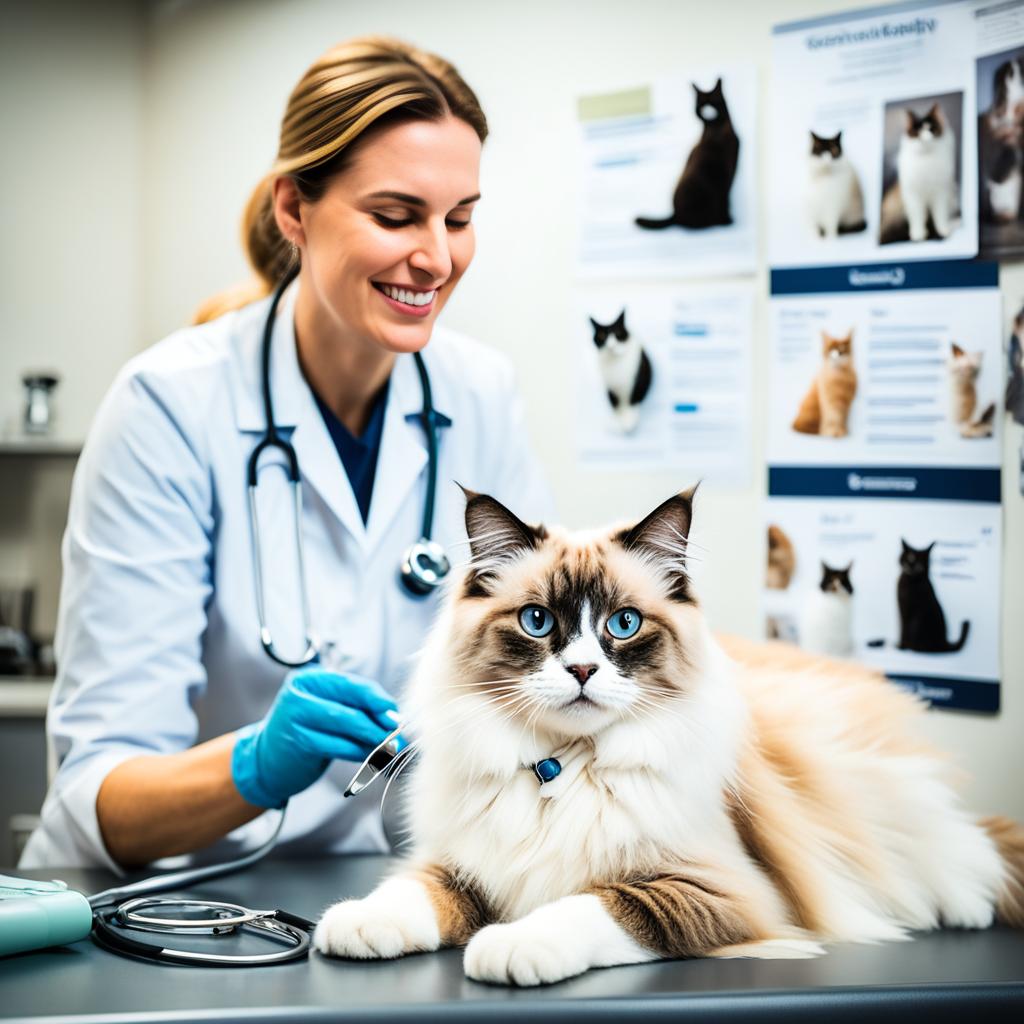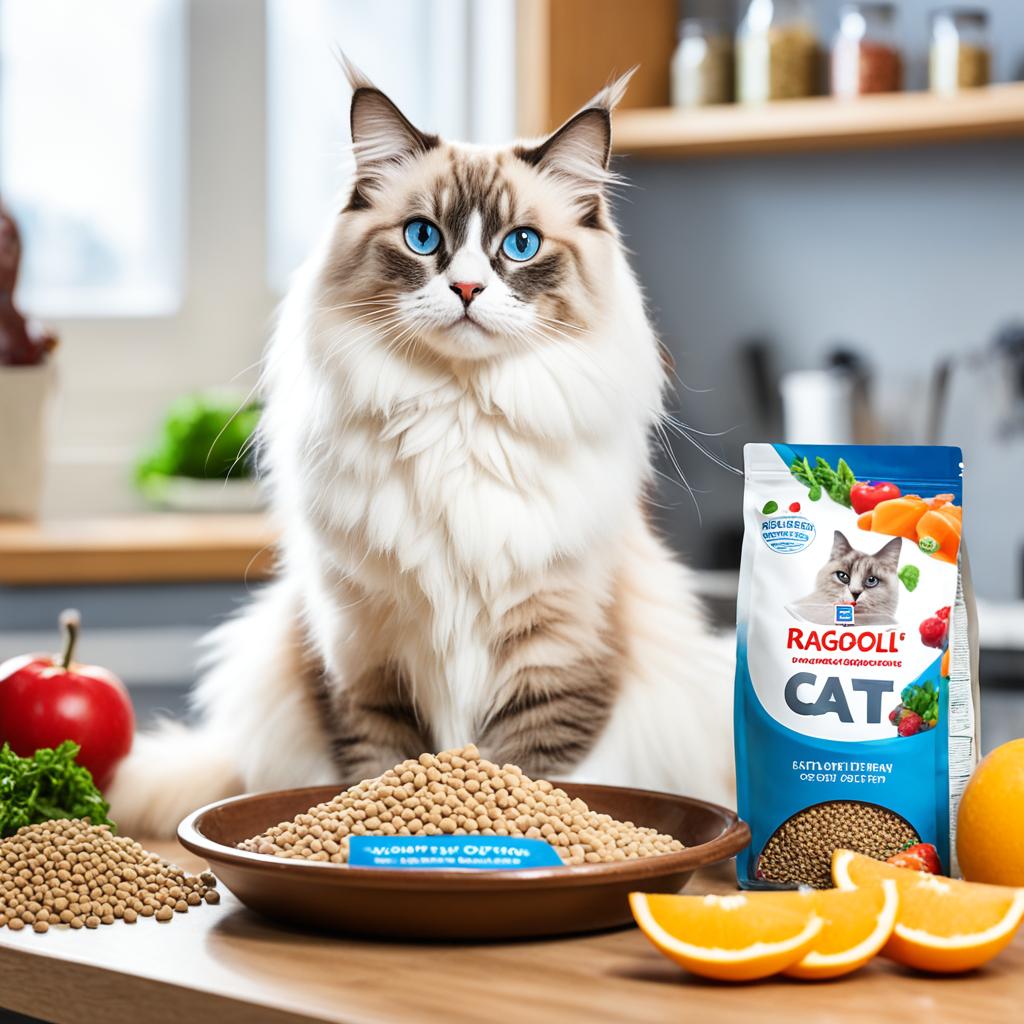Have you thought about if your friendly Ragdoll cat is sick but hiding it? Ragdolls can hide their symptoms well. This makes it important to be alert to signs of illness in them. Watch for big changes in behavior or small changes in how they groom. These signs can tell you something’s wrong early.
Notice if your cat is spending more time alone or is acting more aggressive. These could show they’re not feeling well. Also, keep an eye on their bathroom habits, how they breathe, and if they’re grooming too much or too little. Signs to watch for are if they suddenly gain or lose weight, have tummy issues, or if their eyes or ears look off. With regular vet visits and taking care of their diet and well-being, you can catch any problems early. This way, your Ragdoll has a good chance of getting better fast.
Key Takeaways
- Look out for changes in your Ragdoll’s behavior and grooming habits.
- Pay attention to variations in litter box usage and respiratory issues.
- Regular veterinary checks are essential for early detection and treatment.
- Maintain a balanced diet and stay updated on vaccinations.
- Creating a stress-free environment is crucial for your cat’s overall well-being.
Common Symptoms of a Sick Ragdoll Cat

Knowing when a Ragdoll cat is sick is key to quick help and proper care. Watching for changes in how your cat acts can show if they are ill. This early warning is important.
Changes in Eating Habits
A big sign of a sick Ragdoll cat is different eating habits. If they eat less, it might be due to a health issue. Eating more can be a sign of metabolic problems. Noting these changes early can help you spot illness.
Unusual Weight Loss or Gain
Changes in weight without a clear reason can mean health issues. Weight loss might point to hyperthyroidism or kidney disease. In contrast, quick weight gain could be a sign of bloating, hypothyroidism, or Cushing’s disease. Regular weight checks and chats with the vet can help manage these sick Ragdoll cat symptoms.
| Symptom | Possible Health Issue |
|---|---|
| Loss of Appetite | Illness or Metabolic Problems |
| Increased Appetite | Metabolic Issues |
| Weight Loss | Hyperthyroidism, Kidney Disease |
| Weight Gain | Bloating, Hypothyroidism, Cushing’s Disease |
Behavioral Changes to Watch For

Your Ragdoll cat’s behavior changes can be tricky. They might signal health issues. It’s important to notice and grasp these changes. This keeps your cat healthy and happy.
Increased Hiding or Aggression
Is your Ragdoll cat hiding more or being aggressive? This might mean they are sick or not feeling well. Ragdolls are usually very loving and calm. So, if they act out, it’s a big deal. This behavior could point to problems like infections or pain. An expert vet can figure out what’s wrong.
Changes in Litter Box Usage
Watch your Ragdoll’s litter box use closely. If they pee a lot, struggle, or avoid the box, they could be sick. Often, this shows something like a urinary tract infection or more serious problems. You must deal with this fast. If issues continue, see your vet right away. Early detection and treatment are key to your cat’s health.
Identifying Respiratory Issues in Ragdolls

Do you hear snorting or wheezing from your Ragdoll? These could signal respiratory issues. Cats often get upper respiratory infections. If these sounds continue, seek medical advice for your cat.
The Feline Herpes Virus is a key suspect in chronic respiratory problems in cats. If your Ragdoll keeps wheezing, see a vet. Getting help early can prevent severe issues later.
- *Snorting or wheezing* – don’t ignore these sounds.
- Upper respiratory infections may escalate if untreated.
- Chronic Feline Herpes Virus requires timely care to control recurrent episodes.
Let’s review the symptoms and what to do about them:
| Symptom | Possible Cause | Recommended Action |
|---|---|---|
| Snorting | Upper Respiratory Infection | Consult Vet |
| Wheezing | Chronic Feline Herpes Virus | Long-term Treatment Plan |
While respiratory problems in Ragdolls are concerning, you can take steps. Stay alert and keep in touch with your vet. Being proactive can help your cat feel better.
What Are the Signs of a Sick Ragdoll Cat?

It’s key to watch your Ragdoll’s coat for tips on their health. If you see their coat is messy, or they are grooming way too much, your pet might not be feeling well.
Unkempt or Over-groomed Coat
A messy or oily coat could mean your cat is sick or tired. Too much grooming, on the other hand, causes bald spots and itchy skin. Your cat might be stressed, anxious, or have signs of allergic reactions in cats. It’s important to look into these issues and maybe seek help from a vet.
Excessive Shedding
If your Ragdoll is shedding a lot, it is a warning sign. It might point to hyperthyroidism or skin allergies. Taking good care of their coat is crucial. Any big changes in their shedding or coat should prompt a visit to the vet.
| Condition | Possible Cause | Recommended Action |
|---|---|---|
| Unkempt Coat | Illness or Fatigue | Seek Veterinary Care |
| Over-grooming | Stress or Allergies | Identify and Address Triggers |
| Excessive Shedding | Hyperthyroidism or Skin Allergies | Veterinary Consultation |
Recognizing Eye and Ear Problems

Your Ragdoll cat’s eyes and ears show a lot about its well-being. Watching over these parts can catch problems early.
Discharge or Redness
Seeing discharge, redness, or swelling near your cat’s eyes or ears means trouble. This might mean eye or ear problems due to infections or irritations.
Cloudy Eyes or Uneven Pupils
Cloudy eyes or different pupil sizes mean you need to act fast. Such signs could point to serious health issues. Also, keep your cat’s ears clean to avoid ear troubles.
Understanding Dental Health Issues

Maintaining good Ragdoll dental health is key to a happy, purring pet. Smelling bad breath could mean more than a fishy dinner. It might be a sign of gum disease in cats.
Dental issues can come out of nowhere, affecting both you and your pet. Bad teeth can even cause heart problems over time. Make sure to brush your cat’s teeth often and visit the vet yearly.
So, what hides in that cute mouth? Here are some tips to prevent gum disease in cats:
- Identify Bad Breath: Smelly breath could point to tooth problems.
- Regular Brushing: Brushing a few times a week keeps teeth healthy.
- Vet Visits: Yearly check-ups with your vet are crucial to prevent issues.
Taking care of Ragdoll dental health means a healthier, longer life for your cat. Just a little care ahead of time can make a big difference!
Dealing with Digestive Problems

Does your Ragdoll cat go to the litter box a lot more or leave messes? Digestive issues are quite common in Ragdolls. It’s wise to keep an eye on their symptoms to catch problems early.
Frequent Vomiting or Diarrhea
Is your Ragdoll throwing up or having loose stools often? This could mean their gut isn’t okay. These issues are not just minor problems. They could signal bigger stomach issues needing quick help. Digestive troubles can cause dehydration and more.
Indicators of Gastrointestinal Problems
Look out for more than just vomiting and diarrhea. Signs like laziness, a big belly, and behavior changes matter. Ragdolls are usually friendly and loving. So, noticing any change is crucial. Take care with their food, introducing new stuff slowly to protect their belly.
If your Ragdoll shows such signs, see the vet soon. Early vet help can fix stomach problems before they get worse.
| Symptom | Possible Cause |
|---|---|
| Frequent Vomiting | Food Intolerance, Poisoning, Panleukopenia |
| Diarrhea | Infections, Dietary Changes, Parasites |
| Lethargy | Dehydration, Internal Discomfort |
| Bloated Abdomen | Gastric Issues, Obstruction |
Staying alert and acting fast with stomach issues in Ragdolls can keep both you and your cat happy and healthy.
The Importance of Regular Veterinary Check-ups

Regular vet check-ups are vital for your Ragdoll cat‘s health. They help uncover hidden problems early. This can be a slight change in weight or behavior. Annual exams give a full look at your cat’s health.
At these visits, your vet will handle shots, diet discussions, and watch for any new issues. These check-ups act as a protective barrier. They aim to stop little issues from becoming big problems. Even if your cat appears fine, these visits are crucial.
Veterinary care goes beyond just handling emergencies. It’s a way to keep your Ragdoll joyful and in good shape all year. Make sure you keep up with those regular check-ups for your cat’s well-being.
Dietary Considerations for Ragdolls

The food you choose for your Ragdoll cat is crucial. A diet designed for them can avoid many health issues and help them get better if sick.
High-Protein Diet Recommendations
Choose high-protein cat food to keep your pet healthy. Cats do well with lots of protein. Grain-free foods help lower inflammation and keep them well.
- Choose premium high-protein cat food brands.
- Avoid fillers like corn or soy in their diet.
- Consult with your vet to determine the best protein sources.
Supplement Suggestions
Give your cat extra supplements. Omega-3 is good for reducing swelling and making their fur shiny. Start new supplements slowly to watch for any problems.
“Your Ragdoll’s health can significantly benefit from including omega-3 for cats in their daily diet.”
| Nutrient | Benefits | Food Sources |
|---|---|---|
| Protein | Vital for muscle maintenance and energy. | Chicken, turkey, fish |
| Omega-3 | Reduces inflammation, promotes healthy coat. | Fish oil, flaxseed oil |
| Taurine | Essential for heart and eye health. | Meat-based cat food |
Always consult your vet for a diet plan that meets all your Ragdoll’s needs. This ensures your pet is as healthy and happy as can be.
Preventing Illness with Proper Care
Taking a proactive approach to Ragdoll cat care can keep your pet healthy and happy. It means more than the usual vet check-ups. It’s about creating a stress-free home and making sure they get their shots on time.
Maintaining a Stress-Free Environment
Ragdolls love peace and quiet. They’re sensitive. Design cozy spots where they can feel safe. Use pheromones to calm them.
Playtime is important too. Toys that make them think and move are great. A peaceful Ragdoll is healthier and happier.
Essential Vaccinations
Keeping up with your Ragdoll’s shots is critical. This protects against serious illnesses. It’s the key to a long, happy life for your furry friend.
Regular check-ups help you know what shots they need. A well-vaccinated cat is a healthy cat. This makes life better for you and your Ragdoll.




